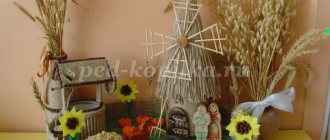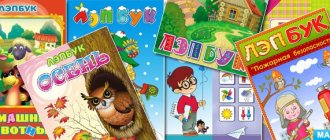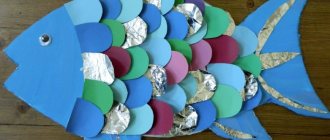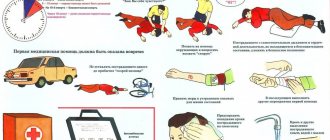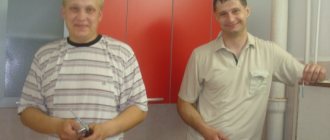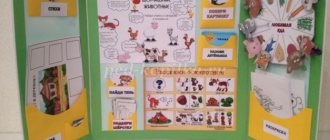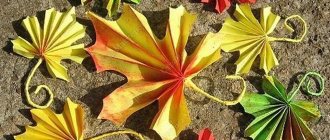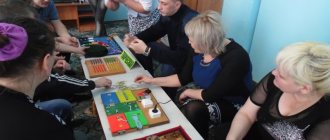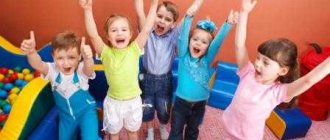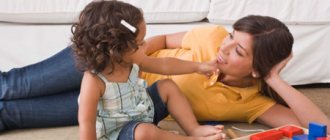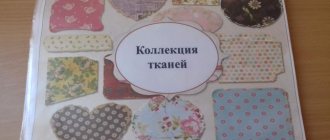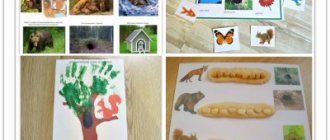How to support your child's passion for geography? Asya Vanyakina, a famous blogger (ozero_chad) and author of the book “Iceberg on the Carpet,” came up with a lot of geographical games for her son Osya. Some of them are described in detail in the book, which will be useful to all mothers interested in the development of their children. Here's what you can do with a world map that once ended up on the floor...
Our geographical games began with a large map of the world during the period of the Axis' fascination with the history of the Titanic. He was then three and a half years old, and one day he asked me to show on the map where the Titanic sailed from and where, and at the same time, where it sank. We made a small liner and a huge iceberg out of plasticine, and Osya spent a long time acting out the story of the Titanic's voyage. And in this story, the legendary ship managed to deftly dodge the icy mountain and happily sail to America.
Since then, the world map no longer hung on our wall - it lay on the floor, and Osya made various trips with the help of small plasticine boats. We often played Columbus and Magellan - we sailed their routes and discussed everything that we came across along the way. I didn’t even notice how Osya remembered the names of the continents and oceans.
Where did our food come from?
It turns out that the products we are familiar with come from the most distant places. The cucumbers that we are so accustomed to and grow in our dachas originated from wild plants in distant India, and apples once upon a time grew only in Central Asia. And to eat fried potatoes, several hundred years ago you would have had to sail to South America. We invite the whole family to play the game “Where did our food come from?”
You will need:
- laminated world map
- paper tape and scissors
- clay to make a dice
- felt-tip pen or circle stickers (I used self-adhesive round furniture pads)
- cards with drawn dishes
- various foods (tomato, cucumber, tea, chocolate, sugar, flour, sunflower oil, vanilla, cinnamon, apple, lemon, onion)
The goal of the game is to collect all the necessary ingredients from different parts of the world to prepare a particular dish and return home. You can decide for yourself what dishes to “cook”. In our game we had three food cards, one for each participant:
- tea with lemon and chocolate;
- Apple strudel;
- salad of tomatoes, cucumbers, onions and sunflower oil.
- Draw and label on the cards the dishes that will participate in the game.
- Take a world map and spread it on the floor. Use paper tape to mark the routes the players will take to get food (the paper tape will easily peel off the laminated surface after the game).
- Tea - from China
- Wheat - from Iran
- Sugar - from India and Southeast Asia
- Chocolate - from the Gulf Coast
- Tomato - from Peru in South America
- Cucumber - from India
- Sunflower oil - from North America
- Lemon - from India
- Apple - from Central Asia
- Vanilla - from Mexico
- Cinnamon - from China
- Onions - from Central Asia
If you want, come up with other dishes and bring rice from China, pasta from Italy, bananas from Malaysia, olives from Greece, pomegranate from Tunisia, oranges from Southern China, pears from the Caucasus mountains, etc.
By the way, in the popular audio encyclopedia with Chevostik and Uncle Kuzya there is an entire audiobook about the history of various vegetables and fruits - “Plant Travel”. (Olga Zhakhovskaya, Natalya Manushkina. Travels of plants. M.: Children's publishing house "Elena", 2005.)
- Make divisions on the routes by sticking or drawing circles on paper tape.
- To play you will need a dice. Make it out of clay and draw on the edges: 1, 2 and 3 dots to indicate the number of moves, a crossed out zero, an airplane and a teapot.
- If a crossed out zero is rolled, the player misses his turn.
- If the plane falls out, the player is instantly transported to any point he needs.
- If the kettle falls out, the player returns to the start, since he forgot to turn off the kettle at home.
- When the clay is dry, the cube can be painted and coated with clear nail polish.
- If you want, place real food on the map before the game starts. Another option is to draw cards. In any case, the child should be able to see where what food is.
- At the beginning of the game, each player draws a card with a dish for which he will collect ingredients. Each participant takes turns rolling the dice and walking. Select your city as a starting point, and you need to return there when all the ingredients have been collected. If your child is still having a hard time with competitive games, then collect ingredients together for the same dish. For example, you can split up: let one go for tomatoes and sunflower oil, and the other travels for cucumbers and onions. And then at the end of the game, when you return home, you will combine the extracted ingredients and you will get a vegetable salad.
- At the end of the game, you can actually cook this or that dish with your child.
Advertising
Game with book characters
This game can have many options: for example, you can turn it into a journey to follow your child’s favorite literary and cartoon characters.
You will need:
- laminated world map
- paper tape and scissors
- self adhesive round pads for furniture
- sheet of paper for cards
- dice
- printed figurines of book characters
- Using paper tape and stickers in the form of circles, lay out routes on a world map from your home to different parts of the world where they live:
- Malysh and Carlson (Sweden),
- Mowgli (India),
- Petson and Findus (Sweden),
- The Little Mermaid (Denmark),
- Cipollino (Italy),
- Pif dog (France),
- Paddington Bear (UK),
- Mama Mu (Sweden),
- Moomins (Finland),
- Pippi Longstocking (Sweden),
- Little Red Riding Hood (France),
- Thumbelina (Denmark),
- Karhlchen (Germany),
- Krotik (Czech Republic),
- Tsar Saltan and Prince Guidon (Russia),
- Vladimir Krasnoe Solnyshko (Ukraine),
- Totoro (Japan),
- Cinderella (France),
- Nemo fish (Australia),
- Tatu and Patu (Finland),
- Pencil and Samodelkin (Russia),
- Olivia Pig (USA),
- Karolinka (Poland),
- Karik and Valya (Russia),
- little penguin Lolo (Antarctica),
- bear cub Umka (Chukotka, Russia),
- Lion Boniface (Africa).
- Prepare cards with questions so that the child has to guess which hero we are talking about. For example, these:
- You need to move the horse from the kitchen to the balcony. Who can help you with this? (Pippi Longstocking)
- You need to build a tower using cubes and meatballs. Who can help you with this? (Carlson)
- You need to take the pies to grandma. Who can help you with this? (Little Red Riding Hood)
- You need to turn into a mosquito. Who can help you with this? (Prince Guidon)
- You need to invent a machine that takes out the things you don't like from food. Who can help you with this? (Tattoo and Patu)
- You need to sew some pants. Who can help you with this? (Mole)
- You need to defeat the poachers of Antarctica. Who can help you with this? (Lolo)
- Print out images of the desired book characters from the Internet, cut them out and place them on a world map.
- The game begins with the participants taking turns drawing a card with a task, reading what question they got, and trying to guess what kind of book character is hidden there. When the child understands who we are talking about, he must find this character on the world map. Discuss with your child the name of the country in which this book character lives, and what is interesting in this country. For example, if the player got Pippi Longstocking, talk about how many other famous book characters live in Sweden - this is Carlson, and Emil from Lenneberga, and Petson with Findus, and Nils, who traveled with the wild geese. Older children can be told about the mighty Vikings, about Charles XII, whom Peter I defeated at Poltava, etc. You can draw several task cards at once. After players guess which characters are hidden there, they need to plot the most convenient route from one hero to another and back to the start.
- When the routes are laid out, you need to roll the dice, count down the required number of moves and collect book characters from different parts of the world. The one who collects the most characters and returns home first wins.
Project “Travel on the Map”
Municipal budgetary preschool educational institution
kindergarten No. 110 “Wonderland”, Penza
Author: teacher: Makshanova T.A.
Project type: creative and informational
Duration: 1 month
Project participants: senior children, teachers, parents
Relevance:
Planet Earth is our common home, every person living in it must treat it with care and respect, preserving all its values and wealth. Caring for nature, awareness of the importance of its protection and restoration, and the formation of environmentally appropriate behavior in nature must be fostered from an early age. It is from preschool age that a positive attitude towards nature is formed. How can we help children learn to sympathize with the surrounding wildlife and care for natural objects? How to teach children to value peace and justice? How to develop a love for nature and the desire to protect it?
Kindergarten is the first link in the system of continuous environmental education, since during this period the child goes through the most intensive spiritual and intellectual path of development. The intrinsic value of preschool childhood is obvious: the first seven years in a child’s life are a period of rapid growth and development, a period of improving physical and mental capabilities, and the beginning of personality formation. At preschool age, the child begins to distinguish himself from the environment, an emotional and value-based attitude to the environment develops, and the foundations of the moral and ecological positions of the individual are formed, which are manifested in the child’s interactions with nature, in the awareness of inseparability with it.
Nature is a rich storehouse, an invaluable wealth for the intellectual, moral and speech development of a child. With its diversity, color and dynamism, it attracts children, evokes a lot of joyful experiences in them, and develops curiosity.
Practical and research activities in natural conditions play a huge role in the environmental education of preschool children. They can be studied in the process of design and research activities. Indeed, in the process of childhood research, the child acquires specific cognitive skills: he learns to observe, reason, plan work, learns to predict the result, experiment, compare, analyze, draw conclusions and generalizations, in a word, develops cognitive abilities. Therefore, children are given an additional opportunity to get involved in research work as the leading way of understanding the world around them. Knowledge of nature is possible only through direct interaction with it, and the most effective method helps us in this - the method of environmental projects, which involves the joint activities of teachers, children and parents.
Project goal: Development of cognitive activity of older children through a joint parent-child project to get acquainted with the diversity of life on planet Earth.
Project objectives:
— Formation of ideas of children of different age groups about the natural zones of the earth (Arctic and Antarctic, desert, savannah, tropical forests, taiga, Australia, ocean), the living conditions of their inhabitants (animals, plants).
— Development of the abilities of preschool children to analyze features, to see the patterns of life in different natural zones.
— Involving parents in the implementation of joint child-parent projects to search for and collect in-depth knowledge of natural areas as active participants in the educational process.
— Development of children’s ability to present prepared information to peers and to perceive new information from peers.
— Enrichment of the group’s subject-development environment, revealing the characteristics of different natural zones and its inhabitants.
— To enable children to understand and apply ways to maintain environmental safety.
Expected Result:
Subject to the implementation of the project, the following results can be assumed:
— Increasing the cognitive activity of children in different age groups through joint child-parent mini-projects to get acquainted with the diversity of life on planet Earth.
— Children will form ideas in the process of their own activity (through the selection of illustrations, searching for educational and encyclopedic literature) about the natural areas of the earth, the living conditions of their inhabitants. Children's ideas will be enriched that the Earth is inhabited by people of different races, their life in different natural zones is different.
— The subject-development environment of the group will be enriched with material that reveals the features of life in different natural zones: pictures, toys, presentations, albums, films, etc.
Integration of educational areas: cognitive, artistic and aesthetic,
social-communicative, speech development.
Project implementation forms:
Activities of the teacher:
- conversations
- educational stories from the teacher
- integrated classes
- reading fiction (fairy tales, short stories, poems, proverbs, tongue twisters)
- use of illustrative material (posters, story pictures, cards, postcards, etc.)
- listening to music
- quizzes
- presentations
Children's activities:
- speech games, descriptive stories
- didactic games with object pictures
- outdoor games
- artistic and productive activities (appliqué, drawing, modeling, manual labor)
Interaction with parents of students:
- consultations, recommendations, reminders
- practical tasks
- joint events
Project implementation:
Stage 1: preparatory . Determining the research topic; drawing up a work plan; identifying children’s prior knowledge on the project topic; formulating research questions; selection of necessary material for project development: illustrations, stories, poems, reproductions; development of organized educational activities.
Stage 2: practical . Organization of children's activities within the framework of the project.
Work with children:
- Creative activities of children;
- Creation of drawings and applications, plasticine prints;
- Game activity;
- Decorating a corner of nature in a group.
Stages of work on the project “Natural zones of the earth”
| Events |
| 1. Conversation “Arctic and Antarctica” Purpose: to introduce children to such climatic zones as the Arctic and Antarctica and their characteristics. |
| 2. Modeling “Cheerful little penguins” Purpose: to introduce children to plasticine and its properties; to develop children's interest in modeling |
| 3. Presentation “Plants and Animals of the Taiga” Purpose: To enrich children’s natural science ideas about nature |
| 4. Drawing “We live in the forest” Goal: Continue to learn how to draw using non-traditional techniques |
| 5. Conversation “Deserts of our planet” Purpose: To introduce the hottest continent - Africa, with climatic conditions, animals and plants of the desert. |
| 6. Manual labor “Cute turtles” Purpose: To become familiar with the features of the external structure of a turtle |
| 7. Presentation “Savannah” 8. Purpose: To introduce the hottest continent - Africa, with climatic conditions, animals and plants of the savannah. |
| 9. Drawing “And camels and rhinoceroses walk along the road” Purpose: Learn to draw a “camel”, conveying its structure and characteristic features in the drawing. |
| 10. Presentation “Tropical Forests” Purpose: To introduce tropical forests, climatic conditions, animals and plants. |
| 11. Modeling “Cheerful Bunnies” |
| 12. Goal: continue to teach children how to sculpt animals |
| 13. Conversation “Australia” Purpose: To give a general idea of the country Australia |
| 14. Quiz game Purpose: Generalization and consolidation of children’s ideas about the inhabitants of natural areas: Arctic, Hot countries, Rainforest |
| 15. Design of the exhibition-vernissage of children's works |
Working with teachers:
- creating a presentation;
Working with parents:
- Joint creativity with children;
- Consultations for parents;
- Decorating a corner of nature in a group.
Stage 3: final.
- Decoration of the vernissage of collective children's creativity;
- Quiz game;
- View a presentation about a project involving children;
Results of the work carried out:
Based on the results of the work, it was noted:
- Developing children's cognitive interest in natural objects of our earth
- Development of research and practical activities during the project.
- Strengthening cooperation between parents and kindergarten.
Conclusion . During the work on the project, the expected results were achieved: we generalized and enriched children’s knowledge about the flora and fauna of various natural zones. We used various forms of activity. During the period of work on the project, children developed emotional and sensory relationships with objects of living and inanimate nature, a value understanding of the organization of environmental activities, and the ability for creative and exploratory activities. During the experimental activities, children developed imagination, thinking, perception, and formed basic research skills. We instilled in children a desire to work, seeing the results of their labor in natural objects. Preschoolers learned to convey their feelings in drawings, crafts and works.
